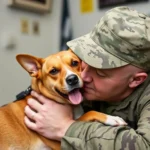
Introduction
Dog health care encompasses a wide range of topics, from nutrition and exercise to behavioral issues. Understanding behavioral challenges in dogs is crucial for their overall well-being, as these issues can significantly impact their quality of life and their relationship with humans. One such behavioral concern is territorial aggression, which can create tension not only within the household but also in the community.
Territorial aggression is a term that refers to a dog’s instinctive reaction to defend what it perceives as its territory. This behavior can manifest in various ways and can be a source of concern for dog owners. In this article, we will explore what territorial aggression is, why it occurs, and how to effectively manage it. By the end of this guide, dog owners will have practical strategies and insights to help them navigate this complex behavior.
Understanding Territorial Aggression in Dogs
Definition of Territorial Aggression
Territorial aggression can be defined as a dog’s instinctive response to perceived threats to its space or territory. Dogs are naturally territorial animals, and this behavior can vary in intensity depending on factors such as breed, socialization, and individual temperament. It is essential to distinguish territorial aggression from other forms of aggression, such as fear-based aggression, which arises from a dog feeling threatened, or protective aggression, which occurs when a dog feels the need to protect its owner or another individual.
Reasons for Territorial Aggression
Several factors contribute to territorial aggression in dogs:
- Instinctual Behaviors: Dogs are descended from wolves, which are inherently territorial. This instinct remains in domesticated dogs, leading them to defend their home, yard, or even their owners.
- Environmental Factors: The dog’s environment plays a significant role in its territorial behavior. A home with a large yard, for instance, may trigger different territorial responses compared to an apartment in a busy neighborhood.
- Breed Characteristics: Some breeds are more predisposed to territorial aggression than others. For example, guarding breeds like Rottweilers and Doberman Pinschers may exhibit stronger territorial instincts.
Signs of Territorial Aggression
Recognizing the signs of territorial aggression is crucial for effective management. Common behaviors exhibited by aggressive dogs include:
- Barking: Excessive barking at perceived intruders.
- Growling: Low growls that signal discomfort or warning.
- Lunging: Fast movements towards the perceived threat, often accompanied by aggressive postures.
In addition to these behaviors, observing body language cues can provide valuable insights. Key indicators include:
- Posture: A tense or stiff body stance may indicate aggression.
- Tail Position: A raised and rigid tail can signal alertness or aggression, while a lowered tail may indicate fear or submission.
- Facial Expressions: A dog showing its teeth or having a wrinkled forehead can be a sign of aggression.
Assessing Your Dog’s Aggression
Evaluating the Situation
To manage territorial aggression, the first step is to evaluate the situation. Identifying triggers is essential; these could include:
- People: Strangers approaching the home or yard.
- Animals: Other dogs or wildlife entering the territory.
- Noises: Sudden sounds that may startle the dog.
Additionally, it’s crucial to observe the contexts in which aggression occurs. For example, does your dog react more aggressively when on-leash versus off-leash? Understanding these contexts can help tailor your management strategies.
Professional Assessment
In some cases, it may be necessary to seek professional assistance. If your dog’s aggression escalates or you are unsure how to manage it, consulting a veterinarian or a certified dog behaviorist is advisable. They can help diagnose any underlying health issues that may contribute to aggressive behavior, such as pain or anxiety.
Strategies for Managing Territorial Aggression
Training Techniques
Training techniques are fundamental to managing territorial aggression. Here are some effective methods:
- Positive Reinforcement: Rewarding your dog for calm behavior can help reinforce desired actions. For example, treat your dog when it remains calm during a visit from a stranger.
- Desensitization and Counter-Conditioning: Gradually exposing your dog to its triggers in a controlled manner can help reduce aggressive responses. Start with low-intensity triggers and gradually increase exposure as your dog becomes more comfortable.
- Specific Commands: Teaching your dog commands such as “leave it” or “come” can help redirect its focus away from perceived threats.
Creating a Controlled Environment
Setting up a controlled environment can significantly reduce the likelihood of territorial aggression. Here are some strategies:
- Setting Boundaries: Use physical boundaries like fences and gates to create a secure area for your dog. This can help prevent encounters with potential triggers.
- Using Barriers Effectively: When guests arrive, consider using baby gates or leashes to manage your dog’s access to the front door or yard.
Socialization and Exposure
Socialization is critical in preventing territorial aggression. Early socialization in puppies can set the foundation for a well-adjusted adult dog. Here’s how to promote positive socialization:
- Controlled Introductions: Gradually introduce your dog to new people and animals in a controlled environment. Start with calm, familiar individuals before progressing to more stimulating scenarios.
Practical Tips for Dog Owners
Daily Routine Adjustments
Making adjustments to your dog’s daily routine can help mitigate territorial aggression. Consider the following tips:
- Regular Exercise: Incorporating daily walks, playtime, or other forms of exercise can help release pent-up energy, reducing the likelihood of aggressive outbursts.
- Mental Stimulation: Engage your dog in mental stimulation activities such as puzzle toys or training games, which can help keep their mind occupied and reduce stress.
Owner’s Behavior Modification
As a dog owner, your behavior significantly influences your dog’s reactions. Here are some tips:
- Stay Calm and Assertive: Your demeanor can impact your dog’s behavior. Remain calm and assertive when encountering potential triggers to convey reassurance to your dog.
When to Seek Professional Help
Recognizing when to seek professional help is essential. Consider consulting a qualified dog trainer or behaviorist if:
- Your dog exhibits severe aggression that poses a risk to others.
- You feel overwhelmed by the situation and require guidance.
- You notice a sudden change in behavior that could indicate underlying health issues.
Long-Term Management and Prevention
Consistency is Key
Maintaining consistency in your training and management strategies is crucial for long-term success. Here are some ways to ensure consistency:
- Routine Training: Regular training sessions reinforce positive behaviors and help maintain progress.
- Behavior Log: Keeping a log of your dog’s behavior can help track progress and identify patterns or triggers.
Understanding the Lifespan of Territorial Aggression
Understanding that territorial aggression may evolve over time is essential. Factors such as age and changes in the household can impact behavior. For example:
- Moving: Relocating to a new environment may trigger renewed territorial instincts.
- New Family Members: The introduction of new pets or people can affect established territorial behaviors.
Adjusting your strategies as your dog grows older or as life circumstances change can help maintain a harmonious environment.
Conclusion
In conclusion, understanding and managing territorial aggression in dogs is a vital aspect of dog health care. By recognizing the signs, assessing the situation, and implementing effective strategies, dog owners can significantly improve their dog’s behavior and overall well-being. Consistent training, socialization, and a calm approach are key components in fostering a positive relationship with your dog.
Continual learning and proactive management will not only enhance your dog’s quality of life but also strengthen the bond you share. Remember, a well-managed dog is a happy dog, and a happy dog contributes to a harmonious household.
FAQs
Can territorial aggression be cured?
While territorial aggression may not be entirely “cured,” it can be effectively managed through training, socialization, and behavior modification techniques.
Are certain breeds more prone to territorial aggression?
Yes, some breeds, particularly guarding breeds, may exhibit more territorial tendencies. However, individual temperament and socialization play significant roles.
How can I tell if my dog’s aggression is serious?
Serious aggression is often characterized by intense growling, lunging, or biting that poses a risk to humans or other animals. If you have concerns, seeking professional help is advisable.
What should I do if my dog bites someone during an aggressive episode?
If your dog bites someone, it is crucial to seek immediate professional help. Document the incident, ensure the safety of others, and consult a veterinarian or dog behaviorist for guidance on managing the behavior.









